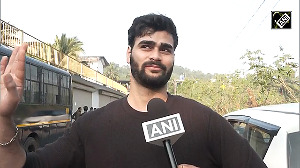Darryl Green is no stranger to turning companies around. As CEO of Vodafone KK in Japan, he converted a loss of $2 billion into a profit of $1 billion in a span of 18 months. Now, as CEO of Tata Teleservices Ltd, the 50-something Green is hoping for an encore.
A late entrant to the code division multiple access (CDMA) cellular space -- the group went national only in December 2004 -- the Tatas are way behind the rest of the pack with a market share of just three per cent. Compare that with Bharti's 21 per cent or BSNL's 18 per cent and you can't be blamed for thinking they have missed the bus.
But make no mistake; telecom is top priority for the Tatas. The basic idea is to cater to the mass market with wireline, cellular, fixed wireless terminal and broadband services and to tap the enterprise space by offering end-to-end solutions through Videsh Sanchar Nigam Ltd (VSNL).
Investment in this gameplan so far: around Rs 15,000 crore (Rs 150 billion) on capital expenditure and another Rs 1,500 crore (Rs 15 billion) on acquisitions. The goal: to be a global integrated player, leveraging strengths in both telecom and information technology.
"Integrating tech with telecom will be important since customers are looking for solutions," says Arvind Mahajan, a partner with IBM Business Consulting Services.
Easier said than done, say critics. Several of the Tatas' telecom businesses are in bad shape. The combined losses of Tata Teleservices Ltd and Tata Tele Maharashtra Ltd are roughly Rs 2,000 crore (Rs 20 billion).
Broadband is yet to take off. With growing competition, VSNL's international long-distance business is on a downswing. And while VSNL's Tyco Global Network and Teleglobe acquisitions look great on paper, it could be a while before they pay off.
Be that as it may, the Tatas do have a few things going for them. They undoubtedly have the tenacity. Not to mention a great brand and a huge war chest. Now, they've also got a strategy chalked out for every one of their telecom businesses.
Step 1: find a strategic partner to bring on board technology upgrades, experience and content. Topping the list of possible candidates is Korea's SK Telecom (FY04: $10.2 billion), which is at the vanguard of CDMA cellular services worldwide. Says Tata Industries managing director K A Chaukar: "We are open to an alliance if the partner can make a meaningful contribution."
At the same time, the Tatas' telecom companies have been pushing subscriber growth ever since they went national eight months ago, rolling out their network from six to 20 circles and going from fewer than 100 towns to 1,540 towns.
In the process, they've added 3.5 million cellular plus fixed wireless terminal customers to the existing base of 1.5 million. Cellular subscriptions have been gathering pace, too: in August, they added 204,000 subscribers, up from 173,000 in July and 106,000 in June. According to Green, the pace will gather momentum. "Right now, it's critical for us to get scale and at 10 million, we can start to breathe easy," he adds.
However, the competition is growing as well. Hutch, for instance, logged 450,000 subscribers in August up from 404,000 in July, while BSNL garnered 595,000 subscribers in August compared to 494,000 in July. The difference in growth, according to analysts, is because the Tatas' marketing has lacked aggression. "They have one of the lowest tariffs, but their advertising has not driven home the point," says one analyst.
That is changing with the new Sabse Zyada Baat campaign featuring film star couple Ajay Devgan and Kajol that highlights full talk time plans aimed at the middle- to upper middle-class market, seen as the key to unlocking volumes. Says Boston Consulting Group director Alpesh Shah: "The Tata brand stands for ethics; it is the only 'true-paid' product in the market."
Tata Teleservices Ltd's president, marketing, Harish Bhat, says that subscription growth has been driven by full talk time plans since the company went national. "We are the only player to offer full talk time consistently, across price points. That it is powerful positioning and dramatically different."
That positioning is expected to garner at least 15-20 per cent of future cellular net subscriber additions, up from around 7.5 per cent right now. Bhat believes that by March 2006, the group should have 10 million cellular plus fixed wireless customers across 4,000 towns.
"We been getting around 25 per cent of the net additions in the last few months," he observes. That will have Green breathing easy.
Or will it? Consultants like Shah warn that the real challenge is to get and retain high average revenue per unit (ARPU) customers. While agreeing that ARPU's are on a downward trend, Bhat believes that volumes would ensure profitability.
"We are already EBITDA (earnings before interest, taxes, depreciation, and amortisation) positive in five circles out of 20 circles. The rest should follow soon," says Green, confidently.
While addressing the mass market by scaling up its cellular and fixed wireless operations, the Tatas are simultaneously seeking to claim a larger slice of global corporate business through VSNL, shifting attention away from the profitable, albeit increasingly squeezed international long-distance business.
The Tyco and Teleglobe buy-outs (the former owns a 60,000 km cable network spread over three continents while the latter sells services to transmit data over the Internet) form a crucial piece in this rejig jigsaw.
"With MNCs looking for global footprints, VSNL needed to access bandwidth, which they have got at a good price," says Mahajan.
Combining VSNL's new assets with the group's established and highly regarded infotech arm Tata Consultancy Services, the Tatas plan to build a global enterprise business, which will be the growth engine for the future. The addressable worldwide market: Rs 5,000 crore (Rs 50 billion), growing at 12-15 per cent a year, according to a BCG estimate.
"We can combine the domain knowledge that we have within the Tata group across industry verticals - be it automobiles or services - with the technology and client strengths of TCS and (TCS subsidiary) CMC to provide a corporate customer with a complete telecom-IT solution," explains VSNL's head of corporate strategy, Srinivasa Addepalli.
VSNL's data centres across 12 global locations, together with Tyco's bandwidth, says Addepalli, will help it cater to companies across the globe. He adds that 20-30 per cent of global connectivity needs could be driven from India. "We hope to be a major player globally in the next four to five years," says Addepalli.
Clearly, VSNL's global appetite has been whet by its recently approved South Africa foray, Second National Operator, which expects to launch commercial operations within six to nine months and would offer a range of services, including voice, data and limited-mobility access.
"Any large market that is opening up offers us a growth opportunity and the Tata group's existing business presence in SA should help us," says Addepalli.
VSNL's other focus area will be broadband, the market for which is estimated at 15 million subscribers in five years. While VSNL lacks last mile advantage, it is setting up a cable network though its plans focus more on the wireless route.
Says Addepalli, "We will create our own cables only in areas where we believe there is sufficient enterprise business to justify the costs. While wireless broadband is still evolving as a reliable technology alternative, even overseas, we are working on various options."
Meanwhile, VSNL has snapped up the network of Tata Power for Rs 239 crore (Rs 2.39 billion) -- that would give it the last mile advantage in large parts of Mumbai and Pune. The cutting edge however, says Addepalli, will come from the content. Says he: "We are tying up with international content providers."
Clearly, it's an uphill task for the Tata Teleservices boss and the team at VSNL. But neither he nor the Tatas have shirked from hurdles in the past. Whether or not Green can take a bow at the end of another successful turnaround, though, remains to be seen.






